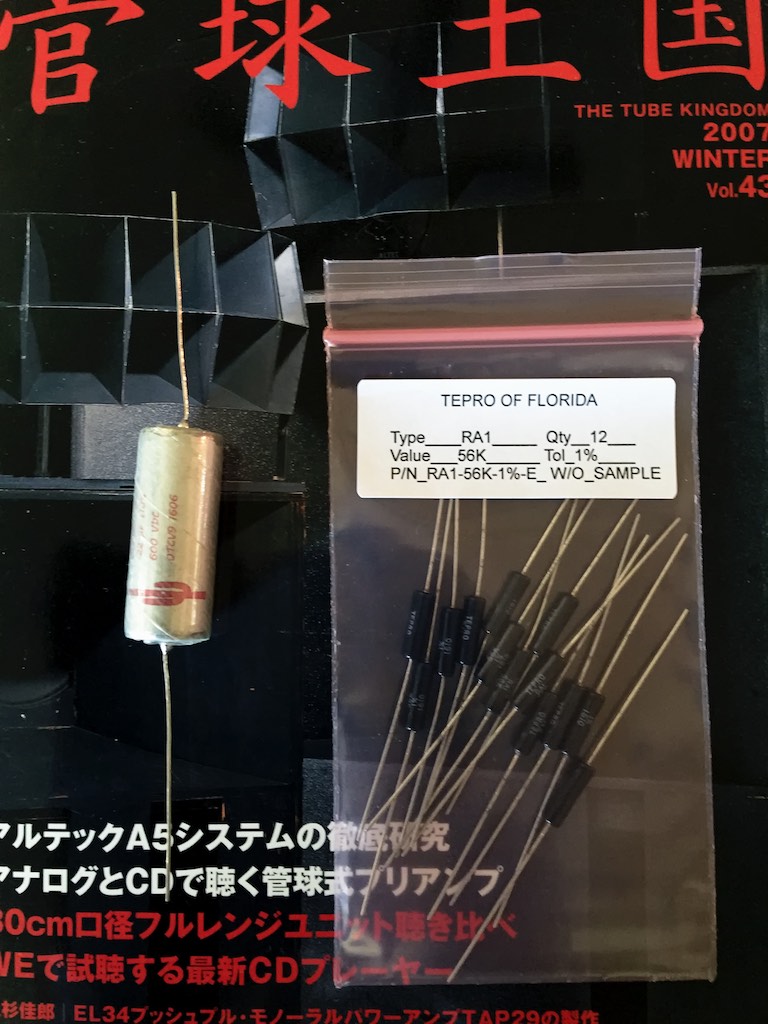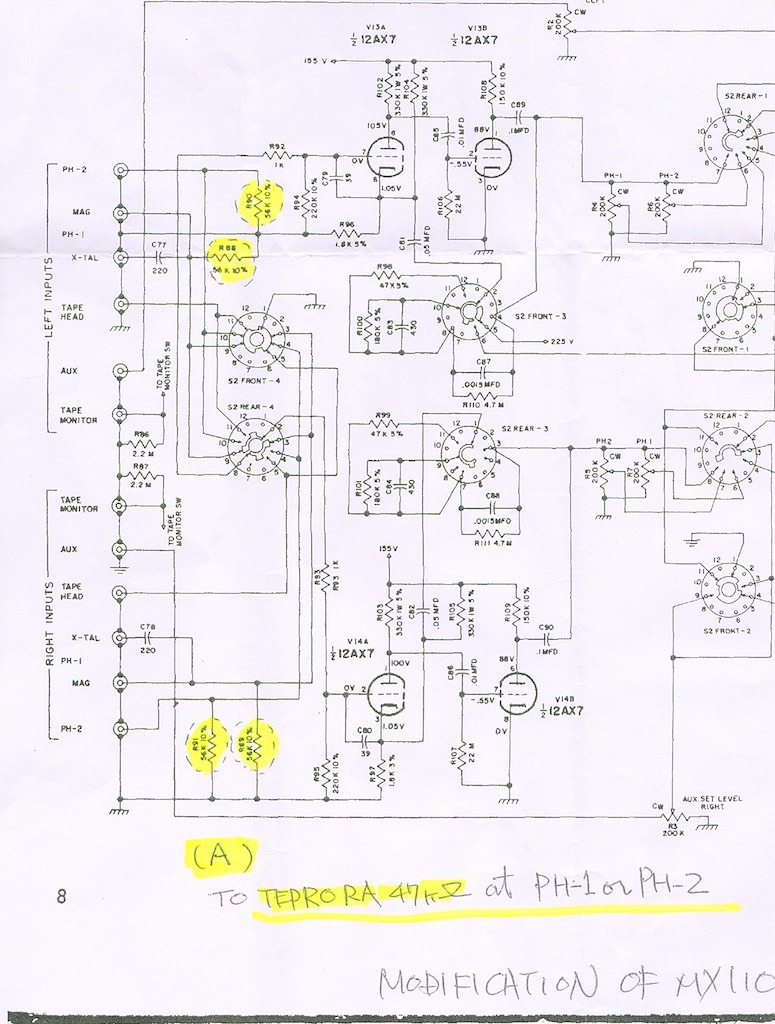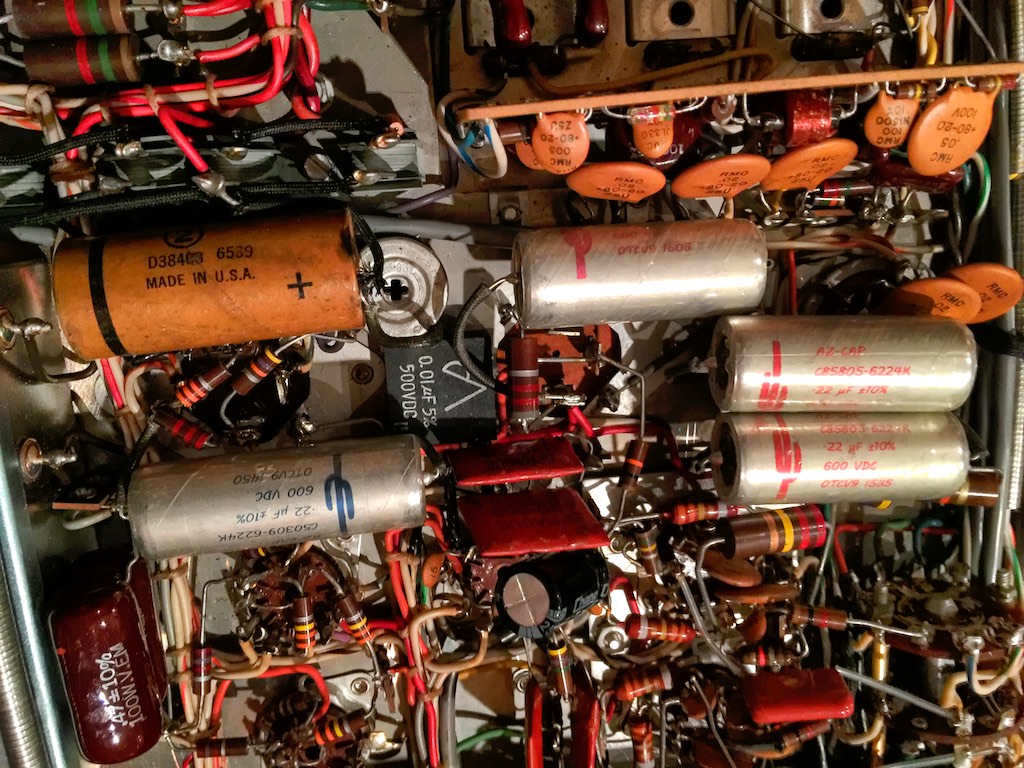I sure have been busy lately, it seems, and I haven't been able to keep up with the blog posts I've been wanting to write for you, or to respond to your comments as speedily as I'd like to.
If I forgot to answer a comment you directed at me, ping me again, because it is my intent to answer all comments, but occasionally I'll get distracted and miss one.
After what seemed like one of those 'forever' weeks in the office for the day job, I was once again a free man to get out the soldering iron last night, which was brought about by a couple of packages arriving from Gary (Tepro) & Daryl (Arizona Capacitors).
The first package contained some Tepro RA series 56K Ohm resistors, and the second package a pair of Arizona Capacitors 0.22uF Red Cactus capacitors, that I've been wanting to experiment with for the vintage MX110 tuner-preamplifier Real Sound Adventure.
By the way, I have some really good news for those of you living in the Americas, you can now easily buy Arizona Capacitors and Tepro RA series metal film resisters in the Western Hemisphere!
Christopher Young over at Jupiter Capacitors is now the master distributor for the Arizona Capacitors series of Red Cactus, Green Cactus, and Blue Cactus capacitors. Christopher told me they will be available in a range of values, and he has just updated their web site to reflect that. That's great news!
I heard from Chris Johnson at Parts Connexion this week too, and he also had some really good news. Parts Connexion is now stocking a range of Tepro RA series metal film resistors, which as you know, are Yazaki-san's favorite resisters. You can see them on the Parts Connexion web site here.
Chris Johnson also told me that Parts Connexion will also have Arizona Capacitors available in the mid-April 2016 timeframe. Chris said, "We will be stocking every cap value that is being offered thru Arizona Capacitors' new master distributor, Jupiter Condenser, in the Green, Blue, and Red Cactus series, about 18 caps values in total."
Chris is also talking with Yazaki-san about offering the SPEC Ruby Mica capacitors through Parts Connexion, so stay tuned on that front!
Gary at Tepro told me, "Parts ConneXion has a worldwide agreement to offer the Tepro RA series resisters, exclusive of the area SPEC covers, and for Arizona Capacitors we have an agreement with Jupiter and SPEC, and that’s it."
I've been writing about Arizona Capacitors and Tepro RA resistors for quite a while now in our Real Sound Adventures, but they've been really hard to come by in the Americas, which is a bit of an irony, given they're made in the USA, but now you can get them easily - that's a cause for celebration! Woo-hoo!
In the photo above you can see the modifications we made to the MX110Z in Modification B (far right), where we made changes to the first stage cathode follower of the high level input, by replacing two key pairs of 0.1uF capacitors at C93 & C95 and C94 & C96 with the superb 0.22 uF Arizona Capacitors.
In my MX110 we put in a pair of 0.22uF Red Cactus (far right) capacitors at C93 & C95 and C94 & C96 to replace the stock two pairs of 0.1uF capacitors. In Leo's MX110 we put in a pair of 0.22uF Green Cactus for C93 & C95 and C94 & C96, and in George's MX110 we put in a pair of 0.22uF Blue Cactus for C93 & C95 and C94 & C96.
The idea was that we would be able to compare the performance of the 3 MX110s with their respective sets of Red, Green, and Blue Cactus capacitors to see which was most complementary to the MX110's circuit.
We got caught out though, as there were a couple of things we did that we didn't anticipate would have such a big effect, but did.
The first was the resistor changes we did for Modification A, which didn't work well. We’ve listened to quite a few different resistors now for Modification A, the R88 & R90 and R89 & R91 phono input resistors: the stock Allen Bradley 56K Ohm carbon comp 1/2W resistors, NOS Allen Bradley 56K Ohm 2 watt carbon comp resistors, 56K Ohm Vishay VAR-Series ”naked ladies” z-foil resistors, and NOS 56K Ohm 1/2 watt Shinkoh tantalum resistors (as used on the original Kondo Ongaku amplifier).
I ended up liking the NOS Allen Bradley 56K Ohm 2 watt carbon comp resistors the best, so I went back to those on my MX110 to serve as a baseline for comparison. Of the metal film resistors I liked the 56K Ohm Vishay VAR-Series ”naked ladies” z-foil resistors the best, however, Ron liked the NOS 56K Ohm 1/2 watt Shinkoh tantalum resistors better. They're both really good metal film resistors, but they couldn't hang in there with the almighty Allen Bradley's from a Real Sound perspective.
Both the Shinkoh and the Vishay metal film resistors were more resolving and transparent than the NOS carbon comp Allen Bradley resistors, but hands down, the Allen Bradleys were way more musical, and had a great Real Sound character to them that has swayed every listener to favor them who has heard them in the MX110s.
Now that we have the new Tepro RA 56K Ohm 1/2 watt resistors here, I'll go back and give them a try on the phono inputs, and I'll let you know how they come out in comparison to the others we've tried. Stay tuned.
In the photo above you can see the changes we made for Modification C (see diagram below), where we hot-rodded the power supply of the MX110.
In the C1 modification we added a SPEC Ruby-Mica capacitor (MC103DA, 0.01μF / 500VDC ) to the circuit. Yazaki-san said, "Bridge rectifier circuit has good efficiency but diode’s switching noise level and distribution might be higher or wider than half-wave or full-wave rectification. And mica capacitor’s outstanding performance for high frequency could allow these noise to be able to terminate to the ground. I hope some effects would be promising."
Then we added in C2 & C3 to the circuit. In the photo above you can see the 0.22uF Blue Cactus capacitor at C2, and the 0.22uF Green Cactus capacitor for C3. In between the Blue Cactus & Green Cactus you cans see the black C1 SPEC Ruby-Mica coupling capacitor (it's a little hidden here, the next photo will show it more clearly). Yazaki-san suggested this modification to, “strengthen or lower impedance of the plate power supply. Please select by Jeff-san’s inspiration . Because that each color cap could improve the sound, but If you like Red 0.22 for C93-C96, I would like to suggest you to use Blue or Green. Red with Blue or Red with Green could compensate the character of Red.”
We didn't have enough Arizona Capacitors at the time to try every permutation, so what we did was if we used Red Cactus caps for modification B (my MX110), then we used a Blue Cactus plus Green Cactus for C2 & C3 in the power supply. For Leo's MX110 we used Green Cactus caps in Mod B, so we used a Red Cactus plus a Blue Cactus for C2 & C3. For Georges's MX110 where we used Blue Cactus caps in Mod B, we balanced things out with a Red Cactus & Green Cactus at C2 & C3.
Leo's MX110 with the Green Cactus caps for Mod B and the Red & Blue Cactus caps for C2 & C3 in the power supply was the best sounding of the three MX110s, by being the most even-handed from the lows up through the high-frequencies, with no peakiness with female vocals like we were having with my MX110, with the Red Cactus caps for Mod B, and the Blue & Green Cactus caps for C2 & C3. Plus, Leo's MX110 sounded good on pretty much any album we threw at it, whether well recorded or not, which is an attribute that is really important to me.
Given that description we could have just stopped right there and declared victory. Except for one thing. My MX110 sounded stunning on everything except hotly recorded female vocals. It had a way of filling the room with an electrifying presence and spaciousness that the Leo's Green just couldn't match, and I wasn't sure I want to give that aspect of its performance up.
I couldn't help but wonder what would happen if I kept the Red Cactus in place for my MX110, but then modified C2 & C3 in the power supply to be like Leo's, with a Red Cactus & Green Cactus for C2 & C3?
So when I got home from work last night I plugged in my Hakko to warm up while I opened up the bottom of my MX110 to do a Red Cactus transplant with the Red Cactus caps that were waiting on my doorstep for me when I got home.
I removed the C2 Green Cactus and replaced it with a Red Cactus, then buttoned the MX110 back up and installed it back into the system.
After letting it warm up for a suitable period I played some music to hear what the result of my efforts was. As you might guess, I was particularly interested on how it would now fare with female vocals, so that's what I queued up first. I played selections from Lucinda Williams, Rickie Lee Jones, Alison Kraus, Billie Holiday, and others, that I knew would be challenging.
Well, it's amazing how much changing one capacitor in the power supply can change the overall sound of the MX110 preamplifier. The Red, Green, and Blue Cactus Arizona Capacitors provide a colorful sonic palette to work from to voice the MX110 with (or anything else) to get the desired overall balance.
Adding in the Red Cactus for C2 made a huge difference on female vocals. The former peakiness is for all intents and purposes is gone with a Red & Blue Cactus for C2 & C1 in the power supply. However, some of the room filling, electrifying magic, I was hearing is also gone. Not all of it, but some of it.
I'm going to listen to my MX110 for a while as-is so the new Red Cactus cap can get some time on it, and then see what happens when I compare it directly to Leo's MX110. There's still a couple other C2 & C3 permutations I could try: Red-Red, Green-Green, Blue-Blue, and Green-Red. What fun!
Tomorrow I'm going over to Pete Riggle's to talk about a re-wire of one of my Schick tonearms. As you know, when Rafe & Don visited, we did a Woody SPU & Schick tonearm comparison, and the Woody SPU slapped down my Schick to a surprising degree. The room went dead silent when everyone heard the result of the switch. It was huge. Pete thought a Woody Wire re-wire of the Schick might bring the Schick closer to the Woody SPU in performance. I hope so. Stay tuned, this could get interesting.
Also, I'm really looking forward to hearing Pete's Altec A7 Voice of the Theatre loudspeakers. Pete just finished building a pair of Hiraga-san inspired crossovers for them, and told me, "They sound more like the Voice of God than the Voice of the Theatre now!" Oh boy, oh boy!
Thanks for stopping by, much more to come!

































